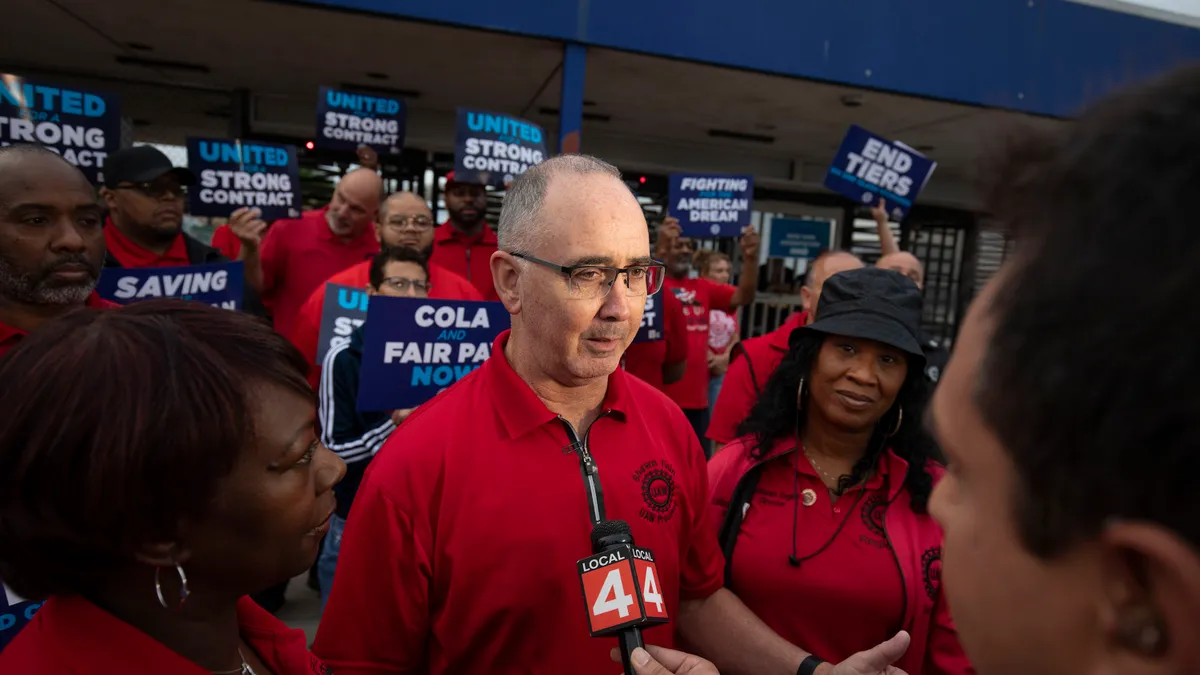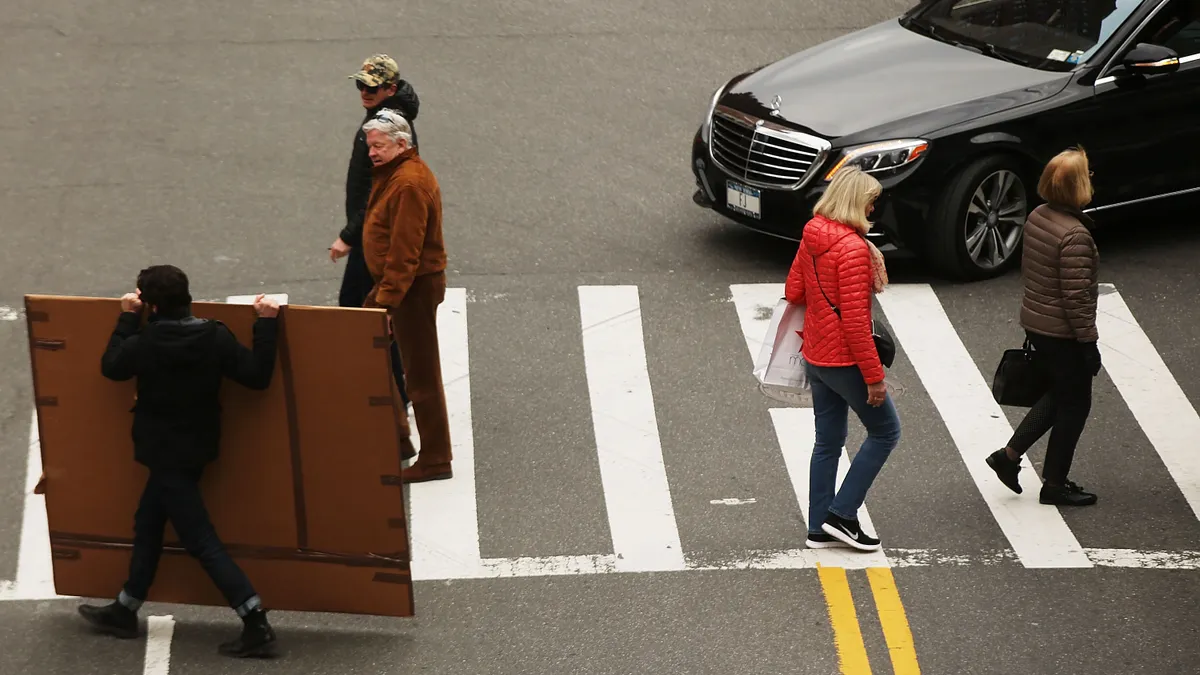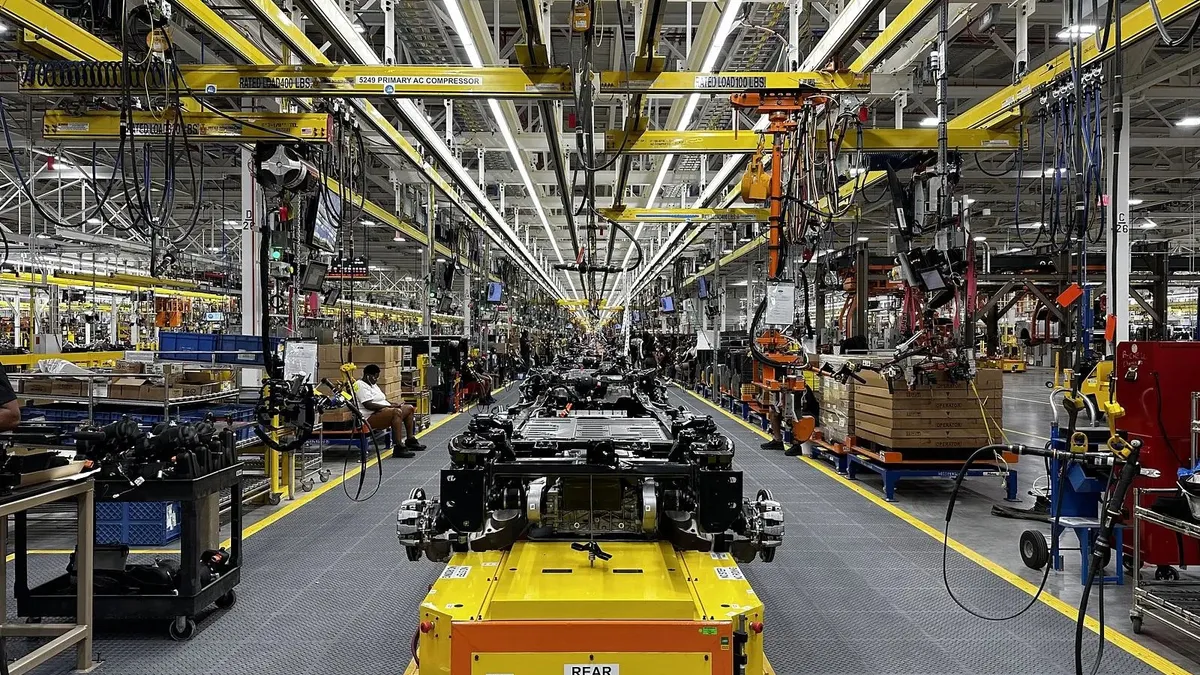In 2019, General Motors shuttered one of its legacy auto plants in Lordstown, Ohio, eliminating or relocating 1,500 jobs. Fast forward a few years, and some Lordstown workers are again working for the carmaker, this time through Ultium Cells, a joint venture between GM and LG Energy Solutions. In operation near the site of the old Lordstown Assembly since 2022, the Ultium plant produces batteries for electric vehicles.
Auto companies like GM “form these joint ventures because they [don’t] want to have any obligation to our workers, to our members,” said Shawn Fain, president of the International Union, United Automobile, Aerospace and Agricultural Implement Workers of America, better known as the United Auto Workers, in an address to the UAW membership via Facebook Live in May. He asserted that such joint ventures allow companies to circumvent UAW contracts and that they “have no obligation to pay a decent standard of living.” Instead, he said, speaking of the union’s goals, “The transition to EV has to be what we’re calling a just transition.”
The Lordstown case represents a key grievance of the UAW, which recently began negotiating new four-year contracts with the Big Three automakers: Ford, GM and Stellantis. The union is demanding an end to tiered wage structures, the reinstatement of cost-of-living allowances and stronger job security amid the shadow of the transition to electric vehicles that has labor leaders worried. Fain promised “our biggest contract campaign ever in our history” in the May address to UAW members.
A new UAW emerges
Since the 1980s, the UAW has regularly taken concessions in labor contracts. But Fain, elected in March after pledging reform following a series of corruption scandals tied to UAW officials, has vowed to take a harder line in negotiations than previous UAW leadership. Fain is the first UAW president to be elected directly by the membership, a new election process resulting from settling the scandals.
“The direct election of Shawn Fain makes a huge difference for the UAW’s strategy,” said Stephen Silvia, a professor of international economics at American University and author of the recent book “The UAW’s Southern Gamble.”
“From now on, if you want to be president of the UAW, you need to win a direct election [which means] you need to deliver on your campaign promises,” Silvia said. Fain ousted the incumbent president in a campaign “committed to fighting against tiers, corruption, and concessions,” according to his campaign website.
With Fain’s outspoken mobilization language, some analysts predict a UAW strike before bargaining begins. With the contract expiring Sept. 14, a strike could start the following day. While each contract is bargained separately, the UAW traditionally utilizes “pattern bargaining,” first targeting one company and then using that agreement to set contract standards for the other two. In 2019, stalled negotiations with the union’s target company, GM, resulted in 48,000 UAW members walking off the job at dozens of GM plants. The strike lasted roughly six weeks, and GM reported losing $2.9 billion due to the strike. The resultant contract with GM was then used in negotiations with Ford and Stellantis.
Because of the union’s pattern bargaining strategy, Silvia said that each company’s goal is to “avoid being the target” of the UAW. “The three CEOs are going to be playing a game of ‘hot potato,’” he said.
The Big Three are often tight-lipped about their distinct priorities in bargaining. “[W]e have a long history of negotiating fair contracts with the UAW that reward our employees and support the long-term success of our business,” GM spokesperson David Barnas said in an email in which he noted the practice of not speaking to media about negotiations.
Stellantis spokesperson Ann Marie Fortunate said in an email that the company aims to negotiate “a contract that will ensure our future competitiveness in today’s rapidly changing global market and preserve good wages and benefits that recognize the contributions of our represented workforce.”
“Together, we must approach these negotiations with open minds and a willingness to roll up our sleeves to find solutions that will result in a contract that is competitive in the market, provides a path to the middle class for our employees and meets the needs of our customers,” Fortunate said.
Ford did not respond to a request for comment. However, Ford CEO Jim Farley wrote a June op-ed for the Detroit Free Press about how the company has prioritized its workforce, claiming its investments have “well exceed[ed] the commitments we agreed to during our last contract negotiations.”
According to Silvia, Farley’s op-ed tried “to shape things so that the UAW would go after GM and Stellantis rather than Ford.” He said the UAW would target the company from which it believes it can get the best settlement. “Which company can withstand a strike? That’s the one the UAW will avoid.”
The tables have certainly turned since the Great Recession. During negotiations in 2007, the automakers were hemorrhaging money — GM lost $38.7 billion that year alone — and the UAW thus allowed major concessions. At that time, the union agreed to a tiered-wage structure, in which new hires come in at lower wages and with fewer benefits.
Since then, company fortunes have reversed. In 2022, GM took home $9.9 billion in profits before taxes, while Stellantis made $17.9 billion. Ford lost $2 billion because of startup investments, though it made $9.2 billion before taxes and special expenses.
In light of company profits, UAW workers want an end to the tiered system and reinstated cost-of-living adjustments that the UAW first won in the 1940s. They also want better job security, like the right to transfer to other plants and commitments against plant closures.
Silvia said that the auto industry is becoming more competitive worldwide due to increased supply after years of shortages and dampened demand from rising interest rates. Will such profits last?
“Yes, [automakers] have reaped a lot of profits [in recent] years,” said Thomas Kowal, president of Seraph North America, a supply chain and manufacturing consulting firm. “On the other hand, they’re facing massive costs,” he said, particularly with the transition to EVs.
The EV transition is key if the UAW wants to “survive”
The annual Bank of America “Car Wars” report estimates that Ford, GM and Stellantis will all increase their market shares of the American EV market by 2026. However, the report also says that fast EV rollouts, uncertainty around traditional vehicles and last-minute product cancellations will impact the market, and that “the next four-plus years could be some of the most uncertain and volatile for product strategy ever.”
“In this pivotal transition to EVs, it’s very important for the UAW, if it wants to survive and prosper, to get a strong foothold in the new EV plants as they’re being built,” Silvia said.
The Lordstown battery plant unionized with the UAW last December. The UAW wants to include it and the other Big Three EV battery plants in the soon-to-be-negotiated contracts. Besides company profits, the UAW has highlighted that the Big Three receive massive government subsidies to produce EVs. For example, Ultium, which operates two other plants in addition to the Lordstown location, recently received a $2.5 billion loan from the Department of Energy and will be eligible for billions from the new advanced manufacturing production credit.
These subsidies are partly why the UAW has promised to withhold an endorsement of President Joe Biden until their concerns with the EV transition are addressed. “The federal government is pouring billions into the electric vehicle transition, with no strings attached and no commitment to workers,” Fain wrote in a letter to members in May.
Writing that the EV transition “was at serious risk of becoming a race to the bottom,” he said that “[w]e want to see national leadership have our back on this before we make any commitments.”
A strike seems likely
Strikes by auto workers have less impact on the wider economy than they did in previous decades because of the increasing influence of foreign automakers. GM has the biggest U.S. market share of any car company, but still takes just 16.7% of the market. Ford has 13% while Stellantis holds 10.5%, according to estimates by Cox Automotive. The three companies together control roughly 40% of the American auto market; comparatively, the Big Three held more than 71% of the American market in 1989.
Auto suppliers, however, would be impacted by a strike, Kowal said. Suppliers “have been squeezed the past couple of years [and] are not sitting on a lot of inventory,” he said.
Kowal, who noted that auto parts were often built in-house at Big Three companies decades ago, said that faced with the costs of building inventory to prepare for a potential strike, suppliers are likely to wait and lay off workers if a strike occurs.
And the reduced market share of the Big Three over the past decades is “putting pressure on the UAW to gain membership,” Kowal said. The UAW is “going to have to show [their] members that [they’re] fighting,” he said, “and the [strongest] weapon they have is to go on strike.”
The UAW currently has more than $800 million in its strike fund, which could last several months according to analysis by Seraph. A strike is not ideal for workers: strike assistance is $500 per week, which is much less than workers’ regular pay, which can grow to more than $30 an hour, or $1,200 per week.
Bank of America auto analyst John Murphy said at a press event in June that he is highly confident a strike will occur, predicting the UAW’s target company will be Stellantis. Murphy’s reasoning was based partially on the fact that Fain, the new UAW president, was a longtime Stellantis factory worker. Fain is not the only one — three of the four other UAW executive board officers, who ran and were elected with Fain as part of a slate, also worked at Stellantis.
As reported by Reuters, Stellantis put two Michigan plants in “critical status” to ramp up vehicle production between July and early October, possibly requiring seven days a week of work in addition to overtime. While Stellantis indicated the status change was due to increased sales, some workers at one of the plants believe Stellantis is aiming to “build up inventory ahead of a potential strike.”
The UAW is ready to use its more aggressive negotiation strategy regardless, aiming to force changes at the Big Three and targeting the greater industry shifts that threaten its workers, from electrification to joint ventures.



















